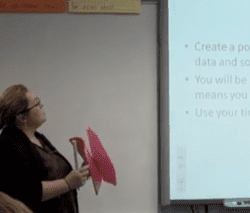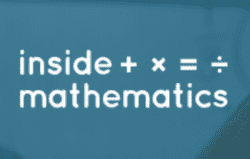Molly McNinch teaches high school mathematics at Woodside High School in Sequoia Union High School District, Woodside, California.
This video was recorded her third year of teaching. Woodside High School is diverse ethnically (56% Hispanic/Latino, 32% White, and about 12% other ethnicities), linguistically (16% English language learners), and socioeconomically (48% socioeconomically disadvantaged) as of 2015. In addition, about 13.2% of the student population is recorded as individuals with disabilities.
The lesson documented in this set of videos is from Molly’s Enriched Geometry 9th-grade class (Molly also teaches algebra and mathematics support). She observes that “Enriched Geometry class…[is a] slightly more rigorous class, and the students who are in Enriched Geometry are the upper level of Geometry students… The difference is with Enriched we go slightly further in the concepts and slightly deeper.”
In this lesson, Molly’s students are being asked to work in pairs to
– compare the motion of real-world rolling geometric cup shapes to that of cups in a computer simulation,
– predict which cup shapes will generate larger or smaller circles when rolled, as measured by the outer, “drinking” rim of the cup, and
– share their thinking so far via a visual “status representation” on a large poster.
To achieve these goals, Molly’s students need to understand the ways in which the top diameter, bottom diameter, and slant height of the cups — as well as the radius of the circle path each cup traces when rolled —relate to and are distinct from each other.
The work represented in this set of video clips is the middle segment of an original Classroom Challenge, “Modeling Motion: Rolling Cups,” developed by the Mathematics Assessment Project:
– “Before the lesson, students watch a video of Rolling Cups. They then work on a related task designed to assess their current approaches to modeling. You [the teacher] collect and review students’ work and write questions to help improve their models.
– “During the lesson, students first work individually to review their initial work. They then work in pairs to compare their approaches to the task, choosing a strategy that will produce an improved model and together implement that strategy. Students next review some sample work before discussing as a class the strengths and weaknesses of different approaches to the modeling task.
– “In a follow-up lesson, students review their work on the task.”
Molly also engages in a substantive pre- and post-lesson coaching conversation with colleague and Sequoia Union High School District math lead Jim Karditzas.




